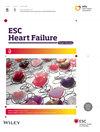Circulating CD19 B cell count, myocardial injury and clinical outcomes in patients with heart failure
Abstract
Aims
Heart failure (HF) is a steadily increasing health problem associated with a high mortality rate. Lymphocytopenia is common and reportedly associated with poor clinical outcomes in patients with HF. Alterations in circulating lymphocyte subsets have not been examined. The current study focused on the CD19 cell count, B cells and examined whether alteration of lymphocyte subsets can predict clinical outcomes in patients with HF.
Methods
Three hundred ninety-five consecutive patients with HF were enrolled (mean age 73, 59.6% men). Circulating lymphocyte subset counts (CD3 cells: T cells; CD19 cells: B cells; and CD56 cells: NK cells) were evaluated. All patients were prospectively followed for a median period of 374 days. The primary and secondary endpoints were all-cause mortality and HF-related events, respectively.
Results
Simple linear analysis indicated that circulating CD19 B cell counts negatively correlated with heart-type fatty acid-binding protein levels (r = −0.3669; P < 0.0001). The C-index of the CD19 B cell count for all-cause mortality was the highest among the lymphocyte subset counts (C-index 0.73085 vs. 0.69063, 0.65312, 0.60117). Multivariate Cox proportional hazard regression analysis demonstrated that the CD19 B cell count was an independent predictor of all-cause mortality and HF-related events after adjusting for confounding risk factors [hazard ratio (HR) 0.57; confidence interval (CI) 0.45–0.71; P < 0.0001 for all-cause mortality; HR 0.79; CI 0.64–0.98; P = 0.0293 for HF-related events], but not for other subset counts. Adding the CD19 B cell count to the basic risk factors significantly improved the C-index for all-cause mortality, with a significant net reclassification index and integrated discrimination improvement (C-index 0.8000 vs. 0.7609; P = 0.0256).
Conclusions
Circulating CD19 B cell counts correlated with myocardial injury and could be a feasible marker for clinical outcomes in patients with HF.


 求助内容:
求助内容: 应助结果提醒方式:
应助结果提醒方式:


